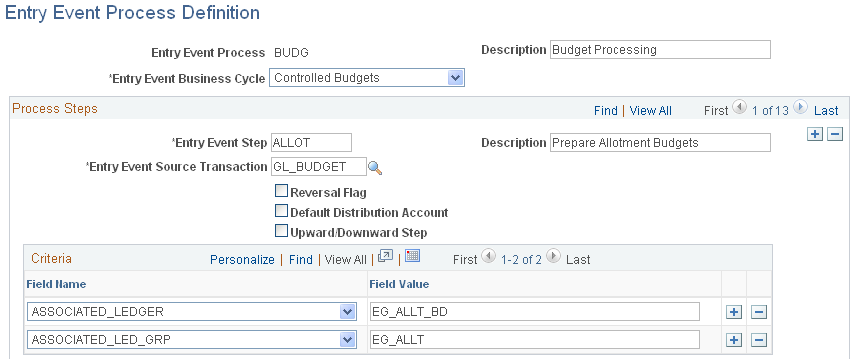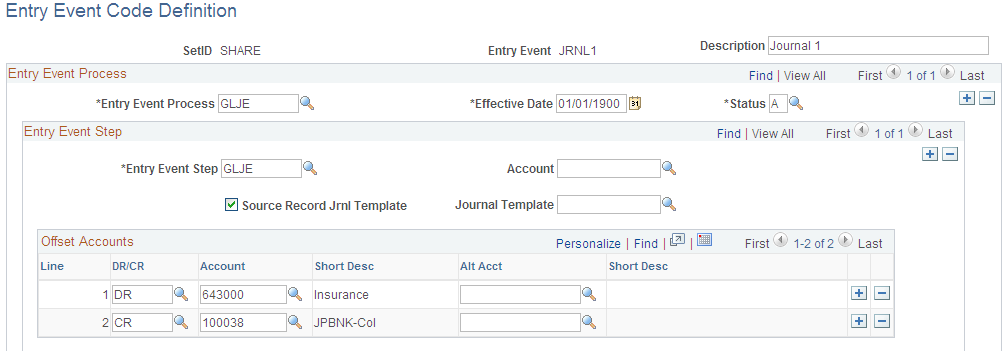Setting Up Entry Events
To set up entry events, use the Entry Event Code Definition component (EE_EVENT_CODE_DEFN), the Entry Event Process Definition component (EE_PROCESS_STEP), and the Entry Event Source Definition component (EE_SRC_DEFN).
Note: Entry event source definitions, entry event processes and steps are predefined in the system. Do not change this setup.
|
Page Name |
Definition Name |
Usage |
|---|---|---|
|
EE_SRC_DEFN |
View predefined entry event source transaction definitions with the data structures and records that are used by the entry event processor. Warning! Do not modify any entry event source transaction definitions. |
|
|
EE_PROCESS_STEP |
View a predefined series of steps that are grouped by a process for similar processing. A step is predefined for each transaction type that the process includes. The entry event processor runs each step within the process. Do not modify these steps. BUDG and PCBUDG processes are exceptions. See the previous table titled PeopleSoft Products That Use Entry Events for details. |
|
|
EE_EVENT_CODE_DEFN |
Define entry event codes that are selected or entered into the application's detail distribution lines as part of an accounting transaction. |
Use the Entry Event Source Definition page (EE_SRC_DEFN) to view predefined entry event source transaction definitions with the data structures and records that are used by the entry event processor.
Navigation:
This example illustrates the fields and controls on the Entry Event Source Definition page. You can find definitions for the fields and controls later on this page.

Field or Control |
Description |
|---|---|
Entry Event Source Transaction and Description |
Identifies the document that is processed. For example, in Purchasing, it differentiates between the requisition, the PO, the payment record, and the voucher accounting line record. |
Source Record |
Identifies the record where the original accounting entries are stored for the related PeopleSoft product: General Ledger, Payables, Receivables, Purchasing, Billing, or Project Costing. |
Target Record |
Identifies the record where the entry event accounting transactions are inserted. |
Temporary Record |
Identifies an additional record for unique processing required in General Ledger and Purchasing. General Ledger uses the temporary record to renumber journal lines and to record General Ledger budget adjustments, and Purchasing uses the temporary record for reversal and adjustment processing. |
Note: Do not modify any entry event source transaction definitions.
Use the Entry Event Process Definition page (EE_PROCESS_STEP) to view a predefined series of steps that are grouped by a process for similar processing.
A step is predefined for each transaction type that the process includes. The entry event processor runs each step within the process. Do not modify these steps. BUDG and PCBUDG processes are exceptions. See the previous table titled PeopleSoft Products That Use Entry Events for details.
Navigation:
This example illustrates the fields and controls on the Entry Event Process Definition page. You can find definitions for the fields and controls later on this page.

Field or Control |
Description |
|---|---|
Entry Event Process and Description |
Displays the process name and description. Entry event processes and steps are normally predefined. However, you can modify processes and steps to accommodate added or modified entry event codes. |
EE Step (entry event step) |
Builds And statements in a Where clause to select rows from the source record. |
Description |
Enter a description of the entry event step. |
Entry Event Source Transaction |
Select the source transaction to associate with the step. |
Reversal Flag |
Select to reverse the source transaction. |
Default Distribution Account |
Select to have the process post to the default distribution account that you identify on the Entry Event Code Definition page. |
Upward/Downward Step |
Select for the entry event processor to use this step for processing entry events codes that are associated with upward and downward adjustments. |
Field Name |
Select field names from a list of values in the source record that are defined according to the system source transaction setup. |
Field Value |
Enter values for all fields except the APPL_JRNL_ID field, which uses the APPL_JRNL_ID template as a field value. The APPL_JRNL_ID value for the General Ledger business unit is selected at run time. The system uses the field value mapping to build Where clauses that differentiate the various lines to create the additional entries. All fields listed have And statements in the Where clause. |
Note: The PeopleSoft system delivers the entry event processes and steps with your products in the sample data. However, you can add, update, and correct processes and steps using this page.
Use the Entry Event Code Definition page (EE_EVENT_CODE_DEFN) to define entry event codes that are selected or entered into the application's detail distribution lines as part of an accounting transaction.
Navigation:
This example illustrates the fields and controls on the Entry Event Code Definition page. You can find definitions for the fields and controls later on this page.

Field or Control |
Description |
|---|---|
SetID |
Enter the same SetID that you use to set up the business unit and ChartFields. This prevents entry event processing errors. |
Entry Event |
Create a code to represent the type of entry event process to run. |
Description |
Enter a short description of the entry event code. The description appears on reports, lists, and inquiries. |
Entry Event Process |
Select the entry event process that applies to the entry event code. |
Entry Event Step |
Select the step that applies to the selected entry event code. |
Account |
Enter the default distribution account for use on the Entry Event Process Definition page. |
Source Record Jrnl Template (source record journal template) |
Select to carry the journal generator template identified in the source transaction to the entry event transactions. Some source transaction records have the journal generator template (APPL_JRNL_ID) populated during the posting process. Some documents (such as budget journals) do not use a journal generator template and do not require that you select this check box. |
Journal Template |
If you do not select the Source Record Jrnl Template option, you must select a journal template to use for the transaction. You receive an error if you select both the source record journal template and a journal template. Typically, documents that are posted through a posting program (voucher post, payment post, AR Update) use a journal template. Other documents that are not posted do not have the journal template populated in the document. The Entry Event processor populates the journal template on the Entry Event accounting record so that they can be journal-generated. Note: You receive the default journal template, such as EE_PCBUD for Project Costing , EE_PURCH for Purchasing and EE_BUDGET for PeopleSoft General Ledger budget transactions in the DEMO database. You can use these journal templates as guides for setting up the templates in your database. |
Offset Accounts |
Add the accounts and alternate accounts, if required, to debit and credit for this entry event code during processing. |
DR/CR (debit and credit) |
Enter DR or CR for offset accounts that are automatically generated when the entry event generator is run. You can have two or more DR/CR pairs associated with each entry event code. |
Alt Acct (alternate account) |
Select DR/CR for alternate accounts, if applicable. |
Note: If an entry event code is copied from one document to other documents, it must be defined as a valid code for the entry event process associated with each type of document. For example, if an entry event code is entered into a PO that can be copied to a voucher, the entry event code definition must include the entry event process for the PO and the entry event process for the voucher. If the code is not defined for both, a processing error occurs due to an invalid entry event code.